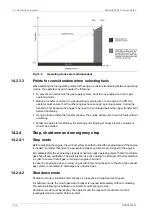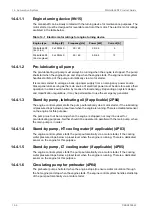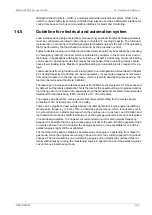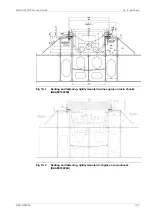
14.2.4.3
Emergency stop mode
The sequence of engine stopping in emergency stop mode is similar to shutdown mode,
except that also the pilot fuel injection is de-activated immediately upon stop signal.
Emergency stop is the fastest way of manually shutting down the engine. In case the emergency
stop push-button is pressed, the button is automatically locked in pressed position.
To return to normal operation the push button must be pulled out and alarms acknowledged.
14.2.5
Speed control
14.2.5.1
Main engines (mechanical propulsion)
The electronic speed control is integrated in the engine automation system.
The remote speed setting from the propulsion control is an analogue 4-20 mA signal. It is also
possible to select an operating mode in which the speed reference can be adjusted with
increase/decrease signals.
The electronic speed control handles load sharing between parallel engines, fuel limiters, and
various other control functions (e.g. ready to open/close clutch, speed filtering). Overload
protection and control of the load increase rate must however be included in the propulsion
control as described in the chapter
.
14.2.5.2
Generating sets
The electronic speed control is integrated in the engine automation system.
The load sharing can be based on traditional speed droop, or handled independently by the
speed control units without speed droop. The later load sharing principle is commonly referred
to as isochronous load sharing. With isochronous load sharing there is no need for load
balancing, frequency adjustment, or generator loading/unloading control in the external control
system.
In a speed droop system each individual speed control unit decreases its internal speed
reference when it senses increased load on the generator. Decreased network frequency with
higher system load causes all generators to take on a proportional share of the increased total
load. Engines with the same speed droop and speed reference will share load equally. Loading
and unloading of a generator is accomplished by adjusting the speed reference of the individual
speed control unit. The speed droop is typically 4%, which means that the difference in
frequency between zero load and maximum load is 4%.
In isochronous mode the speed reference remains constant regardless of load level. Both
isochronous load sharing and traditional speed droop are standard features in the speed
control and either mode can be easily selected. If the ship has several switchboard sections
with tie breakers between the different sections, then the status of each tie breaker is required
for control of the load sharing in isochronous mode.
14.3
Alarm and monitoring signals
Regarding sensors on the engine, the actual configuration of signals and the alarm levels are
found in the project specific documentation supplied for all contracted projects.
14.4
Electrical consumers
14.4.1
Motor starters and operation of electrically driven pumps
Motor starters are not part of the control system supplied with the engine, but available as
loose supplied items.
DBAD209883
14-7
14. Automation System
Wärtsilä 46DF Product Guide
Summary of Contents for 46DF
Page 1: ...W rtsil 46DF PRODUCT GUIDE...
Page 4: ...This page intentionally left blank...
Page 8: ...This page intentionally left blank...
Page 16: ...This page intentionally left blank...
Page 118: ...This page intentionally left blank...
Page 140: ...This page intentionally left blank...
Page 148: ...This page intentionally left blank...
Page 174: ...This page intentionally left blank...
Page 186: ...This page intentionally left blank...
Page 198: ...This page intentionally left blank...
Page 206: ...This page intentionally left blank...
Page 214: ...This page intentionally left blank...
Page 218: ...This page intentionally left blank...
Page 230: ...This page intentionally left blank...
Page 234: ...This page intentionally left blank...
Page 236: ...This page intentionally left blank...
Page 241: ...Fig 21 7 List of symbols DAAF406507 7 DBAD209883 21 5 21 ANNEX W rtsil 46DF Product Guide...
















































